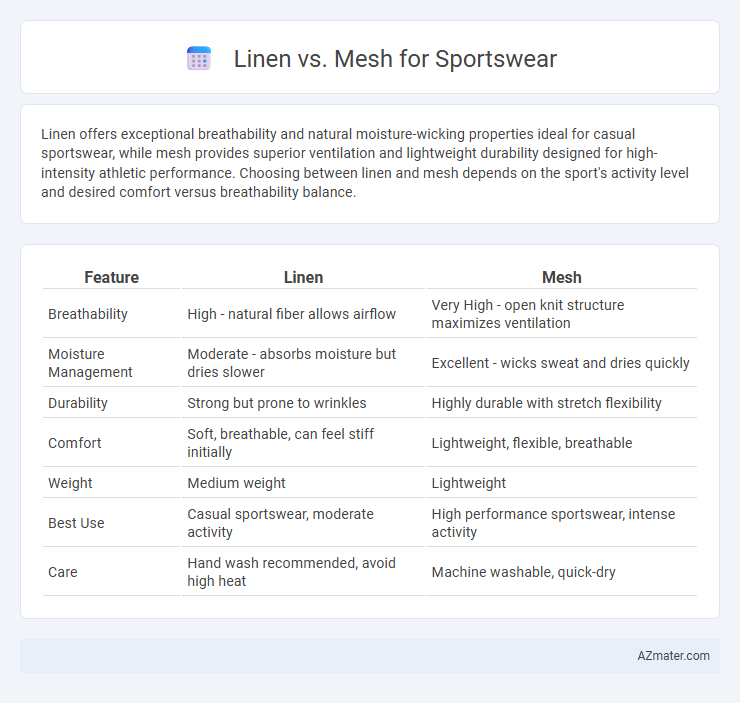Linen offers exceptional breathability and natural moisture-wicking properties ideal for casual sportswear, while mesh provides superior ventilation and lightweight durability designed for high-intensity athletic performance. Choosing between linen and mesh depends on the sport's activity level and desired comfort versus breathability balance.
Table of Comparison
| Feature | Linen | Mesh |
|---|---|---|
| Breathability | High - natural fiber allows airflow | Very High - open knit structure maximizes ventilation |
| Moisture Management | Moderate - absorbs moisture but dries slower | Excellent - wicks sweat and dries quickly |
| Durability | Strong but prone to wrinkles | Highly durable with stretch flexibility |
| Comfort | Soft, breathable, can feel stiff initially | Lightweight, flexible, breathable |
| Weight | Medium weight | Lightweight |
| Best Use | Casual sportswear, moderate activity | High performance sportswear, intense activity |
| Care | Hand wash recommended, avoid high heat | Machine washable, quick-dry |
Introduction to Linen and Mesh Fabrics
Linen, derived from the flax plant, is valued for its exceptional breathability, moisture-wicking properties, and natural durability, making it ideal for lightweight sportswear designed for hot climates. Mesh fabric, typically composed of synthetic fibers like polyester or nylon, offers enhanced ventilation through its open-hole structure, promoting superior airflow and rapid drying during intense physical activities. Both fabrics provide unique benefits for sportswear, with linen excelling in comfort and sustainability, while mesh prioritizes performance and moisture management.
Key Differences Between Linen and Mesh
Linen is a natural fiber known for its breathability, moisture-wicking properties, and durability, making it comfortable for sportswear in warm conditions, while mesh is a synthetic, lightweight fabric with an open knit structure that enhances ventilation and quick drying, ideal for high-intensity activities. Linen tends to be heavier and less stretchable compared to mesh, which offers greater flexibility and better airflow due to its porous construction. The key differences between linen and mesh in sportswear revolve around fabric composition, breathability, moisture management, weight, and elasticity, affecting performance and comfort during various athletic activities.
Breathability: Linen vs Mesh
Mesh fabric outperforms linen in breathability due to its open-weave structure, allowing superior airflow and moisture evaporation, which keeps athletes cooler and drier during intense activity. Linen, while naturally breathable and moisture-wicking thanks to flax fibers, tends to retain more heat and dries slower than synthetic mesh materials. For sportswear prioritizing optimal ventilation and rapid sweat management, mesh remains the preferred fabric choice.
Moisture-Wicking Capabilities
Mesh fabric for sportswear offers superior moisture-wicking capabilities compared to linen, as its porous structure allows faster evaporation of sweat, keeping athletes dry and comfortable. Linen, while breathable and natural, absorbs moisture more slowly and retains sweat longer, which can lead to dampness during intense physical activities. Mesh's engineered fibers and strategic ventilation make it the preferred choice for high-performance moisture management in activewear.
Comfort and Feel on Skin
Linen offers a natural, breathable fabric known for its moisture-wicking properties, providing exceptional comfort and a cool feel on the skin during intense sports activities. Mesh sportswear features a lightweight, synthetic construction with enhanced ventilation through small holes, promoting airflow and rapid drying to keep the skin feeling fresh and dry. While linen excels in softness and natural fiber benefits, mesh delivers superior breathability and moisture management, making each fabric suitable for different comfort preferences in athletic wear.
Durability and Longevity
Linen sportswear offers natural strength and breathability but tends to wear out faster with frequent washing and intense physical activity. Mesh fabrics, typically made from synthetic materials like polyester or nylon, provide superior durability and resistance to abrasion, making them ideal for high-performance sportswear. The longevity of mesh ensures sustained shape retention and moisture management, outperforming linen in rigorous sports environments.
Maintenance and Care Requirements
Linen sportswear requires gentle washing to prevent fiber weakening and frequent ironing to maintain its crisp texture, as it wrinkles easily. Mesh fabrics are more durable in activewear maintenance, often machine washable and quick-drying, with minimal need for ironing due to their synthetic nature. Proper care extends linen's breathable qualities, while mesh's resilience supports frequent use without significant wear.
Style and Aesthetics in Sportswear
Linen offers a natural, textured appearance that exudes a classic, sophisticated style in sportswear, making it ideal for casual, laid-back athletic looks. Mesh fabric provides a sleek, modern aesthetic with its open weave that enhances breathability and creates visually dynamic patterns on sportswear. The choice between linen and mesh affects not only comfort and performance but also defines the overall visual statement and style identity of athletic apparel.
Eco-Friendliness and Sustainability
Linen, derived from flax fibers, offers superior biodegradability and requires significantly less water and fewer pesticides compared to synthetic materials, making it a highly sustainable choice for sportswear. Mesh fabrics, often made from polyester or nylon, rely on petroleum-based polymers and energy-intensive production processes, resulting in higher carbon footprints and less eco-friendly outcomes. Choosing linen sportswear supports reduced environmental impact through natural fiber cultivation and enhanced biodegradability, promoting a sustainable approach in activewear manufacturing.
Which Fabric is Best for Your Sportswear Needs?
Linen offers excellent breathability and moisture-wicking properties, making it ideal for light to moderate activities in warm weather, while mesh fabric provides superior ventilation and flexibility, perfect for high-intensity workouts and maximum airflow. Mesh's lightweight, stretchy construction enhances movement and durability, whereas linen's natural fibers excel in comfort and odor resistance. Choosing between linen and mesh depends on your specific sportswear needs: prioritize mesh for intense physical activity or outdoors, and linen for casual, breathable options in moderate exercise.

Infographic: Linen vs Mesh for Sportswear
 azmater.com
azmater.com